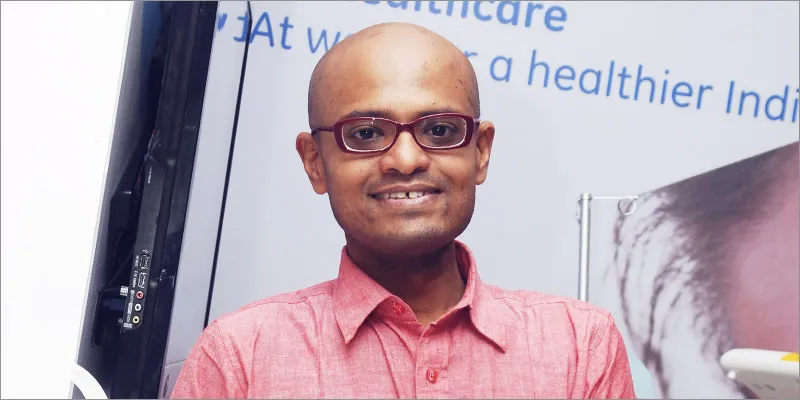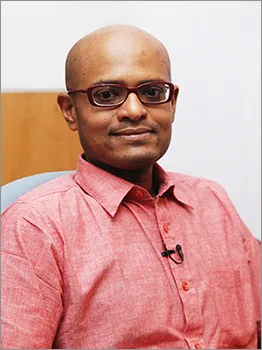Med-tech providing sustainable solutions for healthcare
Sustainable solutions for healthcare continue to pose a challenge. Along with awareness and education, tech innovation is one of the primary means to address this challenge.
Of the 7 billion people living in the world today almost 5.8 billion lack any form of access to scientific healthcare, says Vikram Damodaran, the Chief Product Officer for Sustainable Healthcare Solutions at GE Healthcare. Vikram leads the Centre of Excellence for Affordable Healthcare Solutions serving emerging markets that drive the creation of the Affordable Care portfolio and Global New Market Commercial Activation initiatives. His primary focus is on identifying the most pressing healthcare needs, incubating solutions, attracting seed investments and business model innovation for commercial scalability of these solutions.

SocialStory spoke with Vikram about affordable healthcare, sustainability and GE Healthcare’s efforts in the direction at the CAMTech Jugaad-a-thon in Bangalore. Here are some excerpts:
Pressing health challenges in India
In the context of affordable healthcare we derive challenges by looking at the population of the world that has no access to scientific healthcare. This boils down to communicable diseases and non-communicable diseases. In emerging markets, the visible trend shows a decline in communicable diseases due to targeted interventions and support received from multiple funding organizations like WHO and even the government.
In the case of non-communicable diseases be it cardio vascular, oncology and so on, intervention needs to be broad spread and at the same time it needs to be targeted.
In the context of this background, the four primary sectors of healthcare that we focus on are:
Cardio vascular diseases– With 70 million cardiac patients in India every year and with 150 cardiologists graduating every year, it is impossible to bridge the gap. This requires solutions that not only make the cost of cardiac care come down but you also need to be looking at an ecosystem of solutions that can help bridge expertise gap.
Oncology– India alone has 3 million registered incidents in a year. But if you look at the unregistered events of cancer it is believed to be close to 10 million and that is growing to epidemic proportions.
Mother and child– We produce 30 million babies every year, we joke saying we are producing an Australia every year but we lose a lot of babies every year. Globally a million babies die the same day that they are born, and a lot of this has to do with education and awareness rather than actual clinical intervention.
One area that complements all these three is the availability of affordable and cheaper drugs and vaccines. It is the fourth area of focus and it does not come under a disease per se but it is something that will serve all three areas I mentioned.
Tech solutions and its impact
As part of our Affordable Healthcare Portfolio we launched about 25-26 products about five years ago. The aim is to build products that are clinically good enough to deliver efficacious care but at a cost point that is extremely disruptive in nature. Our lullaby warmer prime for example, meant to take infant care to the masses, is a product designed for use in a primary healthcare setting.
However, even when rooms full of equipment were given to a primary healthcare center, the nurses did not use the products. This got us thinking and the biggest learning from this exercise was that awareness or cheaper products alone are not the solution; cost is just one small cog in the wheel.
It is more about the ecosystem required to use them sustainably. One needs to understand the barriers to adoption as far as the nurse is concerned. With the lullaby warmer we have addressed those issues.
The bassinet in the warmer has an east-west configuration because when we presented a nurse with a

cardboard box with north-south configuration, her concern was that she carries the baby in east –west configuration and to put it into the warmer’s bassinet she would have to move the baby from east-west to north-south configuration and in doing so may drop the baby.Another simple example that will never show up in market research is the cable used to monitor babies’ temperature. The wire needs to be sanitized every time it is removed from the babies skin. It wears and tears and then replacement takes time. We have replaced the nylon wire with Kevlar, a material used in bulletproof vest. Often it is not about keeping the cost low but finding the perfect solution.
Changing mindsets
30 million babies are born in India out of which 8 million are born at home and in many cases without the help of health line workers, ASHA workers or mid wives, it is usually the local dai ma who tries to deliver the baby. Getting people to the health centers needs more than technology and facilities. It needs awareness and incentives. For example, in rural areas women are given money, say Rs. 1000 for a delivery and 3000 for a C-section if they walk into the community healthcare center.
Once the community realizes the benefits of the health centre then a chain reaction will set in.
Accelerate innovation
Personally I have seen a spurt of activity in the med-tech sector in the last five years. The government had invested a lot of money into tech incubation and many agencies that are investing a lot of money for local innovators to focus on med-tech.
There has also been increased participation of the academia. We have direct collaboration with IIT madras in their healthcare incubation centre. The idea of partnering with them is that they bring us amazing resources in terms of engineering skills, scientific skills that can help accelerate innovation.
As the government funds them it gives us access to primary care challenges, which would otherwise not be in our direct line of sight.
Another way of resource creation is bring tech and med schools closer to create cross-pollination of ideas.
When you look at Corporates and MNCs like us one way to create acceleration is to host events like these, create an open innovation platform where it is not about the innovation that comes out but about creating a mindshare for people to get into the med-tech space.
Interestingly the VC’s for example have also started changing their mindset towards investing towards med-tech. It’s one thing to invest in food commerce and food delivery and it is a completely different thing to invest in med-tech and I think that shift is happening slowly.
Also we are trying to get to the roots by conducting these empathy tours to bridge the gap. Our engineers spend a month or more in rural areas to first hand understand the problems people face. This will help them create better and sustainable solutions.
Emerging trends in Med-Tech
From my perspective the few mega trends that we will see will be that patients will no longer be consumers. And as with any consumer, the consumers in healthcare will own what they want to do in healthcare, it will not be about availing services and paying a fee. It will be about prevention. I think the age of prevention is not too far away.
Consumer will be able to choose how much to pay for what outcome and with the amount of big data analytics, sensor tech and all pervasive mobile tech available, many incredible things will happen.
Another mega trend will be that the ecosystem for healthcare- insurance, government, healthcare providers, everything will come together and work towards outcome based health care and not fee for service healthcare and that change will possibly be the pivotal point in the way healthcare will be delivered globally
Given these kinds of trends for a technology company, what it means is that things will become more consumer centric in our approach and bring the patient more close to the innovation roadmap.
What is holding back med-tech innovation
I think we need to break the legacy of long-term incubation. We have to invest in med-tech and the barriers to investing in med-tech need to break down.
Also for investing in med-tech you need deep pockets and the desire that return will not be in terms of money but the final impact had to be about saving millions of lives. That equation takes long periods of time and incubation and that needs to change.
Benefit to participation equation needs to become clear, today it is not clear. It is a niche industry and participation will change when there is more clarity about the benefits of participation.







